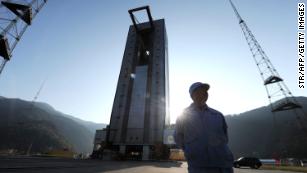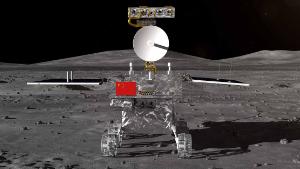Chinese state media announces lunar rover touched down, but quickly deletes tweet
There was uncertainty on Thursday as to whether China had landed a rover on the far side of the moon after Chinese state media outlets deleted announcements posted to social media proclaiming the mission a success.
The China Daily announced in a tweet Thursday morning Beijing time that the highly anticipated landing had gone to plan, "inaugurating a new chapter in mankind's lunar exploration history."
Minutes later, however, the state news site deleted the tweet, sparking widespread confusion as to whether the probe had in fact had made touchdown.
The China Global Television Network also deleted a similar tweet. No explanation was given as to why the tweets were deleted and no subsequent updates were provided.
On social media, observers speculated as to the cause of the apparent backtracking, with many wondering if the mission had experienced an upset, or whether it was a simple case of state media jumping the gun ahead of an official announcement.
The landing, if successful, would be a potential global first and an important milestone in China's attempt to position itself as a leading space power.
The probe entered an elliptical orbit on December 30, passing just 15 kilometers above the moon's surface, state media reported.
The far side of the moon is the hemisphere that never faces earth, due to the moon's rotation. It is sometimes mistakenly referred to as the "dark side of the moon," even though it receives just as much sunlight as its earth-facing side.
The Chang'e 4 lunar mission lifted off from the Xichang Satellite Launch Center in Sichuan province on December 8 and entered the moon's orbit four days later, according to Chinese state media.
Once safely on the moon, the lander will tackle a long to-do list, including conducting the first lunar low-frequency radio astronomy experiment, observe whether plants will grow in the low-gravity environment, and explore whether there is water or other resources at the poles.

The Xichang Satellite Launch Center
Another function of the mission is to study the interaction between solar winds and the moon surface using a new rover.
"Since the far side of the moon is shielded from electromagnetic interference from the Earth, it's an ideal place to research the space environment and solar bursts, and the probe can 'listen' to the deeper reaches of the cosmos," said Tongjie Liu, deputy director of the Lunar Exploration and Space Program Center for the China National Space Administration.
Because of the far side's position facing away from earth, it is free from interference from radio frequencies and therefore it's not possible for the lunar rover to communicate directly with ground control. This is often cited as a reason other space agencies have not landed a probe or rover there before. The mission requires a relay satellite to transmit signals that was launched into place this year.
The Chang'e 4 rover is 1.5 meters (5 feet) long and about 1 meter (3.3 feet) wide and tall, with two foldable solar panels and six wheels.
"China is anxious to get into the record books with its space achievements," said Joan Johnson-Freese, a professor at the US Naval War College and an expert on China's space program.
"It is highly likely that with the success of Chang'e -- and the concurrent success of the human spaceflight Shenzhou program -- the two programs will eventually be combined toward a Chinese human spaceflight program to the Moon," she added. "Odds of the next voice transmission from the Moon being in Mandarin are high."

Pence: New military branch dubbed 'Space Force'
China's last lunar rover -- named Yutu, or Jade Rabbit -- ceased operation in August 2016 after 972 days of service on the moon's surface as part of the Chang'e 3 mission. China was only the third nation to carry out a lunar landing, after the United States and Russia.
The overall design of the new rover is inherited from Jade Rabbit, according to the chief designer of China's lunar probe program.
"We worked hard to improve its reliability, conducting thousands of experiments to ensure its long-term operation, especially taking into consideration rocks, ravines and frictions on the Moon," Wu Weiren told state broadcaster CCTV in August.
Beijing plans to launch its first Mars probe around 2020 to carry out orbital and rover exploration, followed by a mission that would include collection of surface samples from the Red Planet.
China is also aiming to have a fully operational permanent space station by 2022, as the future of the International Space Station remains in doubt due to uncertain funding and complicated politics.
In comparison, despite its recent success in sending a robotic lander to Mars, the US space agency NASA has faced years of budgetary constraints.
China launches satellite as part of mission to explore moon's dark side
Although the Chinese government has long stressed its "peaceful motives" in space exploration, Washington increasingly views China -- along with Russia -- as a potential threat, accusing Beijing of working to bring new weapons into space and prompting President Donald Trump to announce the establishment of a US Space Force by 2020.
The US Congress has barred NASA from working with China due to national security concerns.
"A high percentage of space technology is (civilian-military) dual use," Johnson-Freese said. "The US sees pretty much everything China does in space -- including things the US has done in space -- as threatening."
She suggested that combining military preparedness with diplomatic efforts would best deter perceived threats in space from all sides but added that "unfortunately, the US has not shown interest in diplomatic leadership regarding space security."
News Courtesy: www.cnn.com












